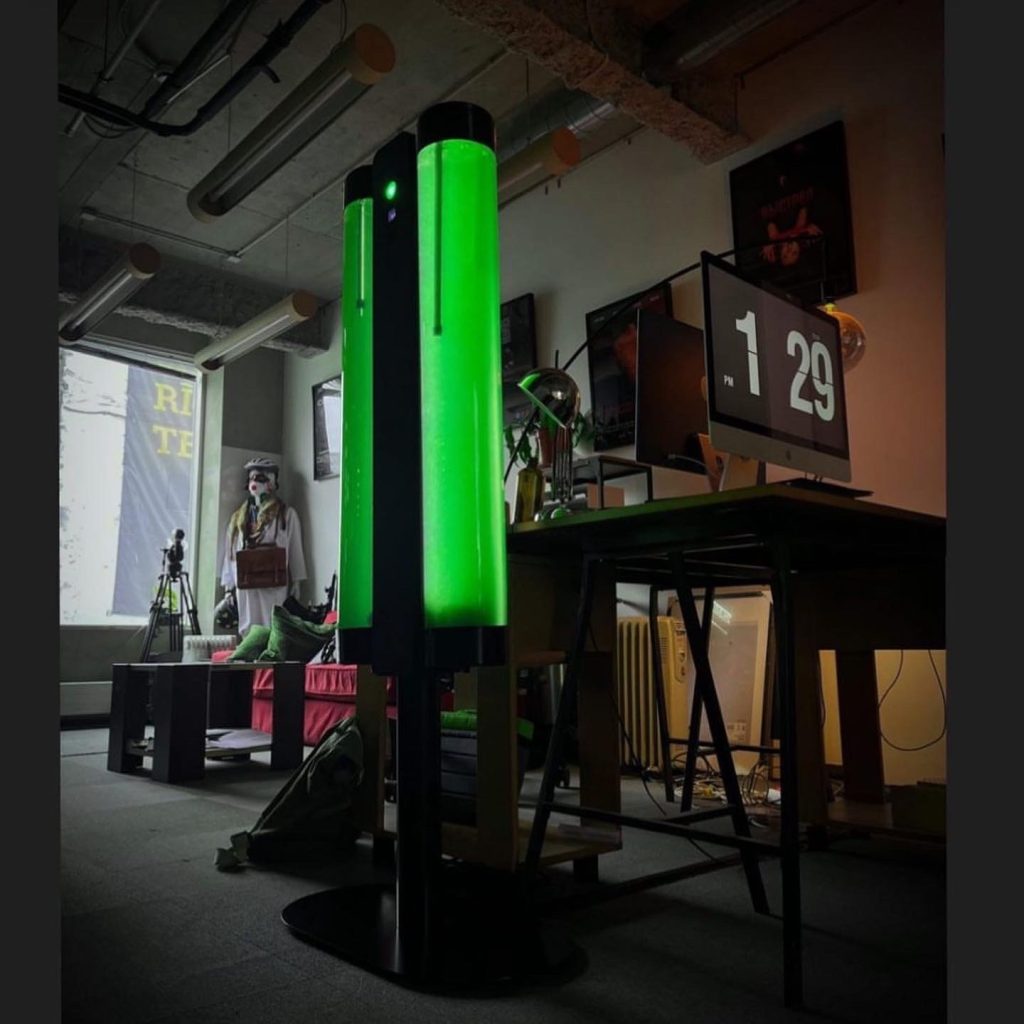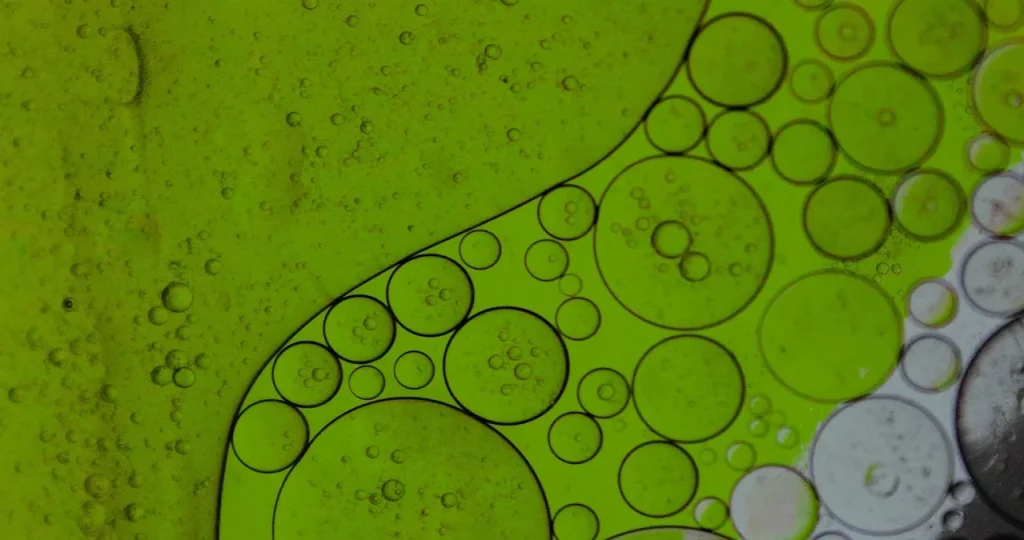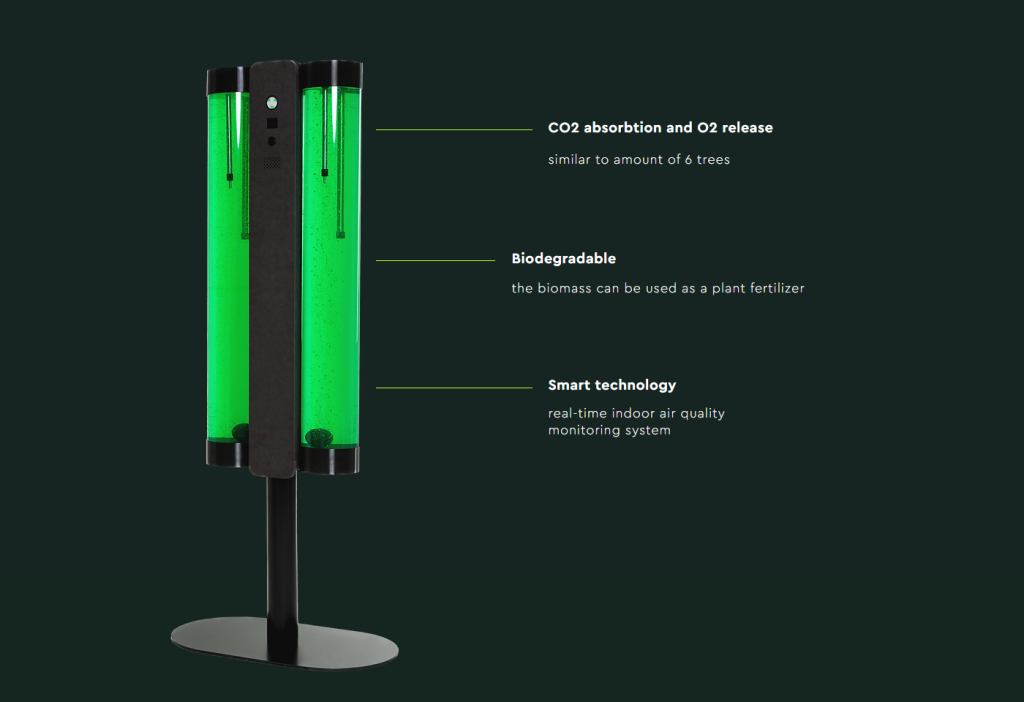
Indoor space air quality is a long-known issue, and has become especially relevant since the pandemic. Unfortunately, not all windows can be opened, and not all windows offer fresh air and quiet. Our active brains need oxygen, and perhaps algae could help?
“Cleaning the air with the help of algae is the logical next step for green walls, which were popular for a while a few years ago,” says occupational disease specialist professor Ivars Vanadziņš. “Basically, the idea is the same – the main goal is to reduce the level of CO2, with the additional benefit of humidifying the air (dry air indoors is a common problem in Latvia), and theoretically, plants could also absorb other harmful substances in the air, such as volatile organic compounds.”
What is fresh air
Guidelines stipulate that indoor CO2 levels should not exceed 1000 ppm – although researchers advocate for changing European guidelines to 800 ppm as the ideal level. However, even achieving 1000 ppm in most rooms cannot be done without constantly opening the window, or a modern and powerful ventilation system. According to Latvian building regulations, the minimum air quality is 15 cubic meters of air exchange per person per hour. Meanwhile, the latest studies suggest a minimum of 36 cubic meters, which is more than twice the current standard. This opens up opportunities for algae, as their use allows for less use of expensive ventilation systems.
Searching for the idea
Alise Jēkabsone encountered the problem of poor indoor air quality when looking for ideas to improve it in apartments where ventilation is limited and without air conditioning: “At that time, I worked from home and spent the whole day in one stuffy room because there was construction outside and I couldn’t open the window. I started researching whether plants could help me, maybe even create a green wall? It turned out to be not only very expensive, but I realized that without a green thumb, it’s not easy to maintain a botanical garden in an apartment. I wanted something simpler – and what could be simpler than algae?”

Most important – knowledge and theory
Shortly thereafter, Alise enrolled in the Academy of Arts, in the Functional Design program, where she continued to study algae and its use in improving air quality, as well as a design project. After completing her studies, she founded the company Algae Tree and began participating in innovation support platforms – first in the “Ideju kauss” competition for young innovators, and then in the Buildit accelerator. During this time, her team also began to expand – chemical technology engineering doctor Agnese Stunda Zujeva, one of the founders of the startup SpirulinaNord, which has been producing healthy food from spirulina microalgae for several years, joined as a consultant. “Until then, my knowledge of microalgae was almost entirely theoretical, based on reading publications, but working with Agnese allowed me to start working with them practically,” says Alise.
Algae have an advantage over indoor plants because they are significantly more effective in absorbing CO2, emphasizes I. Vanadziņš: “Studies on algae vary, and results range from 4 to 50 times more CO2 absorbed. In bioreactors, it can reach even up to 400 times more. Therefore, if we want to grow green mass to get rid of CO2, then algae are definitely the choice. In part, because they are relatively easy to maintain and propagate.” For these reasons, algae are one of the methods scientists offer to combat climate change – by growing them in huge quantities. I. Vanadziņš adds: “Speaking of climate change, even though winters are getting warmer, they are still cold enough to make ventilation very expensive. Quality ventilation systems can retain heat and save money, but they are not cheap to install. On the other hand, summers are getting hotter, and there will be times when it’s too hot outside for simple ventilation with open windows.”
Algae as oxygen producers
The Algae Tree device operates by drawing air from the room through a pump and passing it through a water tank filled with microalgae. The main benefit is the absorption and consumption of CO2 during algae growth and reproduction, which also means that oxygen is produced and distributed in the room. In addition, dust is collected, and research at the Institute of Solid State Physics has shown that heavy metals are also absorbed (which can come from nearby construction, gas stoves, vaping, etc.). “We currently have three 40 L prototypes designed for large spaces,” says Alise. “We have rented them out to offices, exhibited them at trade shows and innovation events, and over the year, we realized that maintaining the devices is not an easy task. It’s a large volume of water full of living organisms, and because of the weight, it takes at least two people to perform maintenance. Therefore, we are currently developing a new, 5 L prototype that is smaller and easier to maintain. We also see it as a much more marketable product, as the device will be more accessible to individual users, not just offices.”
“The main obstacle to overcome for such technology is the fact that if there is a window in the room, opening it can quickly and easily equalize CO2 with outdoor air,” emphasizes I. Vanadziņš. “This is and will remain the best method for improving indoor air quality. That means – this technology needs to target spaces where ventilation is not easy or not possible at all. For example – windows are unopenable, and the central ventilation system is inadequate, or very expensive to use. Perhaps opening the window interferes with room temperature regulation – in places where it is very hot or cold outside. Perhaps in the middle of the city, air quality is very poor or there is noise, and that’s why people don’t want to ventilate. Maybe it could be even used in space! But most likely, as effective as they may be, a lot of these algae would be needed to completely absorb the CO2 exhaled by even one person. Therefore, if we’re not talking about multiple algae-filled baths in one apartment, they won’t be a solution that allows you to comfortably live in a closed space for as long as you want. We need to see this as a solution that works together with other methods of improving indoor air quality.”
Design is crucial for the devices – they not only need to clean the air but also look good in the room. Spirulina algae themselves are beautiful – bright green and without any unpleasant odor. In good conditions, they can live for a long time – six months to a year (when the algae become too old, they start to settle at the bottom of the water tank and form a dark mass). If too many have grown, it is possible to discard some and dilute the remaining amount with water. The discarded algae can be kept as a reserve or poured onto houseplants, for which it is an excellent fertilizer. “They definitely should not be used for consumption though, because even if they are spirulina algae, known for their high nutritional value, they need to be properly and carefully cleaned before consumption,” Alise advises.

Laboratory vs practice
“We have researched whether our prototypes actually affect the air in the room,” explains Alise. “Scientific publications and laboratories say ‘it should happen,’ but it’s much easier for them to ensure effectiveness in perfect conditions, and the results in practice can be different. This was proven by our own tests – when placing the devices in a room, the algae were not as effective as they should have been on paper. So we worked to improve the prototypes and achieve higher effectiveness. One of the reasons was the different environments in the offices where they were placed – different light, air composition, water quality, and so on. We have learned a lot about how to maximize support for algae growth, but we will definitely never achieve laboratory results.”
Vanadziņš also mentions an interesting point – algae do not compete with mechanical local air purifiers. For one, purifiers are practically always less effective than a centralized system, which is cheaper and has better filters. But it is important to note that they do not help to get rid of CO2. Mechanical purifiers can collect dust, microorganisms, and absorb chemical substances. Therefore, these two technologies could be combined – algae primarily deal with CO2, while the filter captures the rest of the pollutants (possibly even protecting the algae from airborne compounds that could affect their health).
Strength in combination
“Initially, we really dreamed that we could completely change the air quality in the room, but now we have realized that this technology works best in combination with other ventilation solutions,” says Alise. “We plan to sell the devices rather than lease them, and then, as needed, send the customer new algae for a fee. It is difficult to predict whether in the future we will produce algae ourselves or continue cooperation with SpirulinaNord. Currently, the main difficulties lie in the need for investments to start manufacturing the devices, although we first plan to complete the aforementioned new 5 L prototype. Like any new venture – we do not expect to easily find enough customers here in Latvia, and we already have many interesting prospects globally.”
This article was created in partnership with Medicus Bonus – a Latvian magazine for healthcare professionals – in a new series about healthcare innovation happening in Latvia. If you are a doctor, the subscription is free – just write to redakcija@medicusbonus.lv !
